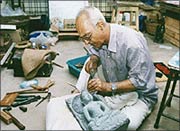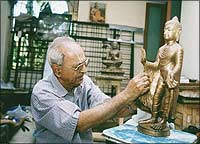The Rediff Special/ Shobha Warrier


"I stood at a distance, awe-struck, as I looked at the imposing figure of the Buddha. Till then I had never seen such a sculpture. This was 30 years ago, but that image is still etched in my mind. It will remain with me forever. When the Taleban destroyed the Bamiyan Buddhas, I died too. Now only my body remains."
Wiping the tears that seem to flow continuously from his eyes, 78-year-old T N Padmanabhan says simply, "These are tears of blood."
Though it is a couple of months since the two majestic Buddhas in Bamiyan, Afghanistan, were destroyed by the Taleban, Padmanabhan still cannot talk about it without choking up. After all, 30 years ago, he was the one who was given the task of restoring the ancient statues.
Today, the verandah of his house is a sculptor's workshop; one can see several small images of Bamiyan Buddha there. His house is filled with sculptures. Even at this age, what gives Padmanabhan happiness is chiselling Buddhas.
Call it coincidence or fate, but Padmanabhan was first fascinated by the Bamiyan Buddhas when, as a college student, he saw their pictures in The Illustrated Weekly of India. He was so fascinated that he stared at the photographs for hours, little realising that one day he would be deputed to restore those very figures.
"At that time," he says, "I wondered how they could carve such a fine figure on rock. It was only when I went there as a project modeller that I realised it was scooped out of clay."
Seeing the real Bamiyan Buddhas was the happiest moment of his life. "It was a dream come true. If the Bamiyan Buddhas were in India, they would have attracted more tourists than even the Taj Mahal."
Padmanabhan's love for Buddha sculptures increased manifold after he became a curator for the Archaeological Survey of India. During the course of his work, he visited several Buddhism-related places like Nalanda, Gaya, Sarnath, Pataliputra and Amaravati to restore Buddha and Mahavir statues.
In 1972, even as an ASI team under Dr Rakhaldas Sengupta worked on a nine-year conservation project in Bamiyan, UNESCO [the United Nations Educational, Scientific and Cultural Organisation] requested for a representative to repair the Buddha statues. Padmanabhan, then working in the ASI museum in Calcutta, was nominated.
 "I had to walk two or three furlongs to reach the statues. I still cannot forget those gigantic images. I stood some 400 or 500 feet away and just stared at them, for the sight was both amazing and intimidating. Mentally, I bowed to the sculptors who had created these magnificent images; it takes great artistic talent to carve such massive figures.
"I had to walk two or three furlongs to reach the statues. I still cannot forget those gigantic images. I stood some 400 or 500 feet away and just stared at them, for the sight was both amazing and intimidating. Mentally, I bowed to the sculptors who had created these magnificent images; it takes great artistic talent to carve such massive figures.
"How would you feel if you stood near a 50-foot image? You feel so small! And the taller of the two statues was nearly 150 feet. What I noticed first was the Buddha's knee, which was at ground level. The legs were embedded deep inside the soil. Since I am both an artist and a sculptor, I immediately noticed the disproportionate figure. The Buddha looked like a dwarf to me. My very next thought was to flee back to India; restoring the figures seemed to me an impossible task. Soon, though, that moment passed; now, all I wanted was to recreate the magic without wasting any time."
He discovered that the curls that had covered the top of the Buddha's head had been chopped off; the top of the statue had become a flat place. So flat, in fact, that on festival days 20-25 people would sit there for a feast. The head of the Buddha had become a dining table for the local people!
The first thing Padmanabhan did was go to the top of the larger statue; the measurements he took convinced him the original figure was as high as 175 feet. When he shared his discovery with the sultan of Bamiyan, he too was astounded and unhesitatingly offered all help. Today, Padmanabhan is all praise for the sultan. He believes he would not have been able to complete his work but for the sultan's encouragement.
Since nearly 35 feet of the statue was buried under soil, Padmanabhan knew he would need labourers to help him with the excavation work. But the sultan could not fulfil his request for workers.
"I asked him, do you have a jail here? The question took him by surprise. I asked him to send me some prisoners whom I could use as labourers; I assured him I would take care of them. When he agreed, I personally went to the prison and selected 150 people. I even invited their families to the site. They were there with me for six months, in the open. Nobody ran away, nobody gave me any trouble and, most importantly, all of them worked exceedingly well."
Once the workers reached the place, he erected a trial pit around the statue and started excavating the legs and feet of the Buddha. The sultan used to visit the place often and the moment the legs became visible, he was so excited he wrote to all the departments in India praising Padmanabhan.
The feet of the Buddha were 13 feet long; the fully excavated statue stood 175 ft! And as they continued digging, they found two new caves.
As there was no place for Padmanabhan to stay in the village, he put up a tent near the statue and stayed there despite the biting cold. A vegetarian, he had gone there well-equipped with adequate supplies of dal, rice, etc. He would cook his own food. Only the rotis came from Bamiyan village.
He even remembers the three baby birds nesting in a hole in the statue and the sultan's specific request about not harming them. Till the last day, Padmanabhan postponed working on the area occupied by the birds. He could not, though, avoid working close to them and was pleasantly surprised by how the mother seemed to trust him; she never tried to peck at or claw him.
"All those who watched me work were surprised. Usually the mother bird was very harsh towards anyone who went near the nest. Whenever a worker brought clay for me, she would try to attack him. In fact, she once pecked a worker so hard that she actually gouged flesh from his head. But she never attacked or even threatened me. I told everyone that since I was sincerely restoring Buddha's statue, he would save me."
And Buddha, he says, saved him more than once. On the last day, he fell nearly 100 feet from one of the scaffoldings. Fortunately he suffered hardly any injuries. He simply got up and climbed back!
"I am sure it was the Buddha who rescued me," he says.
 It took six months for Padmanabhan to finish the restoration work. During that time, he did not visit India even once. "When I take up an assignment, I want to do it honestly. I will come back only after the work is done."
It took six months for Padmanabhan to finish the restoration work. During that time, he did not visit India even once. "When I take up an assignment, I want to do it honestly. I will come back only after the work is done."
In those six months, he restored more than 50 pieces in and around Bamiyan village. All these statues are now believed to have been destroyed by the Taleban.
"When I heard the Taleban were going to destroy the Bamiyan Buddhas, I called ASI's Delhi office and requested the director general to do something. He told me he was helpless; he couldn't help me or save those priceless statues. I was weeping when I talked to him. I couldn't eat for days.
"You might have heard of a mother dying of sorrow when her daughter dies, or a wife dying when her husband passes away. I too will die soon because the Buddhas I had restored with so much love and passion have been destroyed completely by some lunatics. But even at this old age, I am willing to go and repair them because the images are still in front of me."
Photographs of Padmanabhan: Sanjay Ghosh
Page design: Dominic Xavier
The Rediff Specials